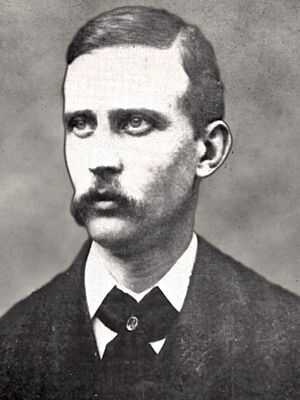H. Newell Martin facts for kids
Henry Newell Martin (born July 1, 1848 – died October 27, 1896) was a British scientist who studied how living things work, a field called physiology. He was also involved in discussions about using animals for scientific experiments.
About His Life
Henry Newell Martin was born in Newry, a town in County Down. His father was a minister. Henry went to college at University College, London and then Christ's College, Cambridge. He studied science and earned several degrees, including a Bachelor of Science (B.Sc.) and a Doctor of Science (D.Sc.).
From 1870 to 1876, Martin worked with a famous physiologist named Michael Foster at Trinity College. In 1876, he was invited to join Johns Hopkins University in the United States. This university was just starting, and Martin was one of the first five main professors hired. He was given the important job of setting up the university's Biology Department and its first physiology program. It was understood that his work would help create the Johns Hopkins School of Medicine, which opened later in 1893.
In 1883, Martin gave a special lecture about how temperature changes affect a dog's heart. Because of his important research, he was chosen to be a Fellow of the Royal Society in 1885. This is a big honor for scientists.
He passed away on October 27, 1896, in Burley-in-Wharfedale, England.
His Scientific Work
Henry Newell Martin made an important scientific breakthrough. He created the first way to study a mammal's heart and lungs outside of its body, keeping them working. This method, first described in 1881, was later used by another famous scientist, Ernest Henry Starling.
He also worked with George Nuttall in Baltimore. Martin helped open the Chesapeake Zoological Laboratory. This lab studied sea creatures and how different species depend on each other. They did their research in various places, from Beaufort, North Carolina, to the Bahamas.
His Ideas and Beliefs
Martin shared and spread the scientific ideas of the "Cambridge school of physiology," which was a group of scientists led by Michael Foster. Their ideas included the theory of evolution, which explains how living things change over time.
He even wrote a book called A Course of Practical Instruction in Elementary Biology in 1875 with Thomas Huxley. Huxley was a strong supporter of evolution. Their book was based on a course Huxley taught to future science teachers. It focused on studying a few types of plants and animals in a lab.
At the time, some people were against experiments on live animals, which is called vivisection. Henry Martin defended these experiments. He explained that "Physiology is concerned with the phenomena going on in living things, and vital processes cannot be observed in dead bodies." This meant he believed you could only truly understand how living things work by observing them while they were alive. He even invited people to his lab to watch his experiments.
Selected Writings
- Introductory lecture, October 23, 1876.
- The Human Body (10th edition online). This book had various co-authors, including his wife for the first edition.
- Collected articles.
Personal Life
In 1879, Henry Martin married Hetty Cary. She was the widow of a general named John Pegram.


